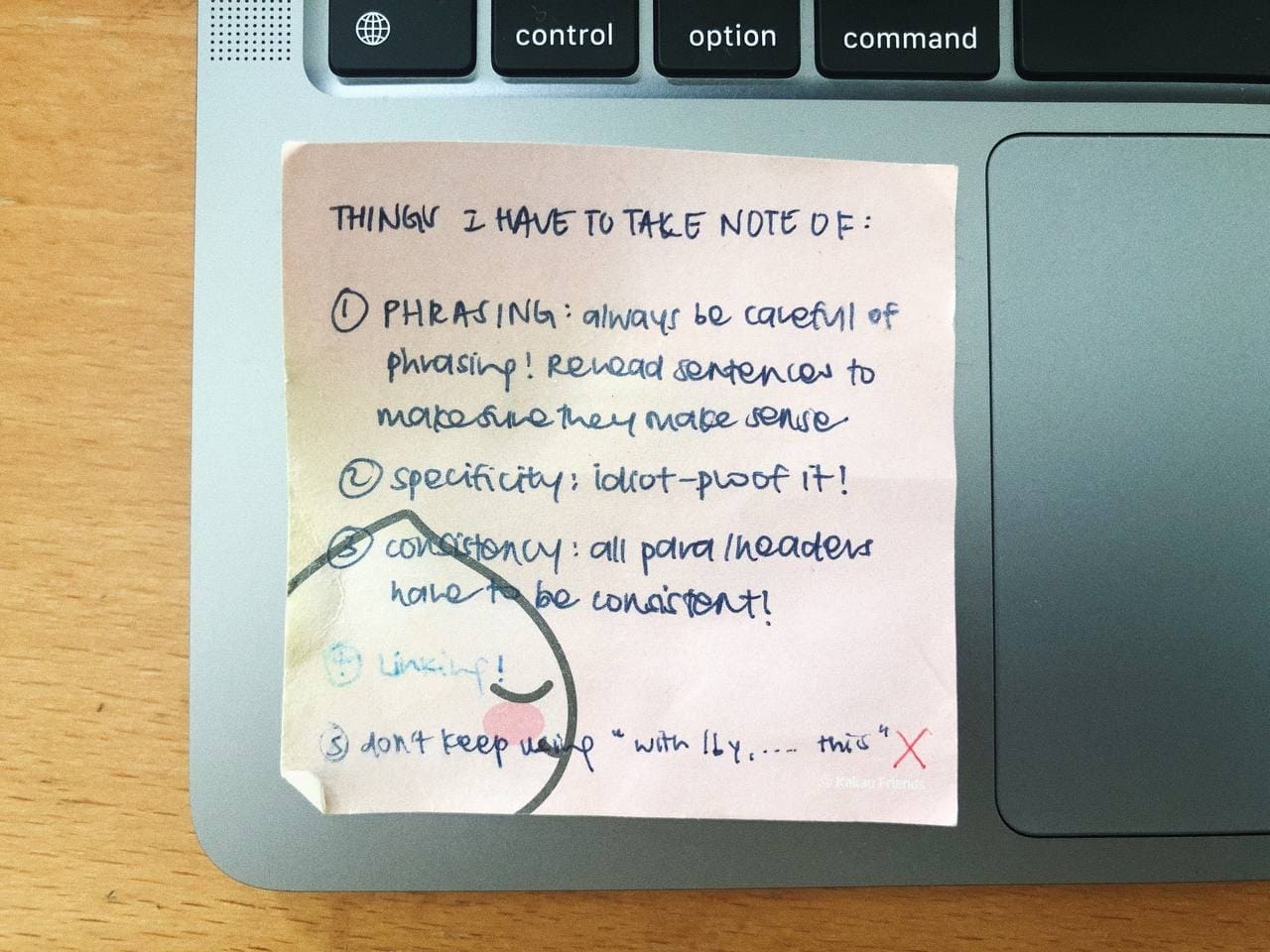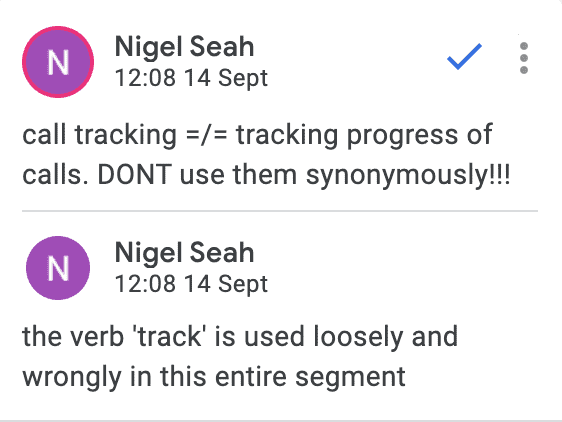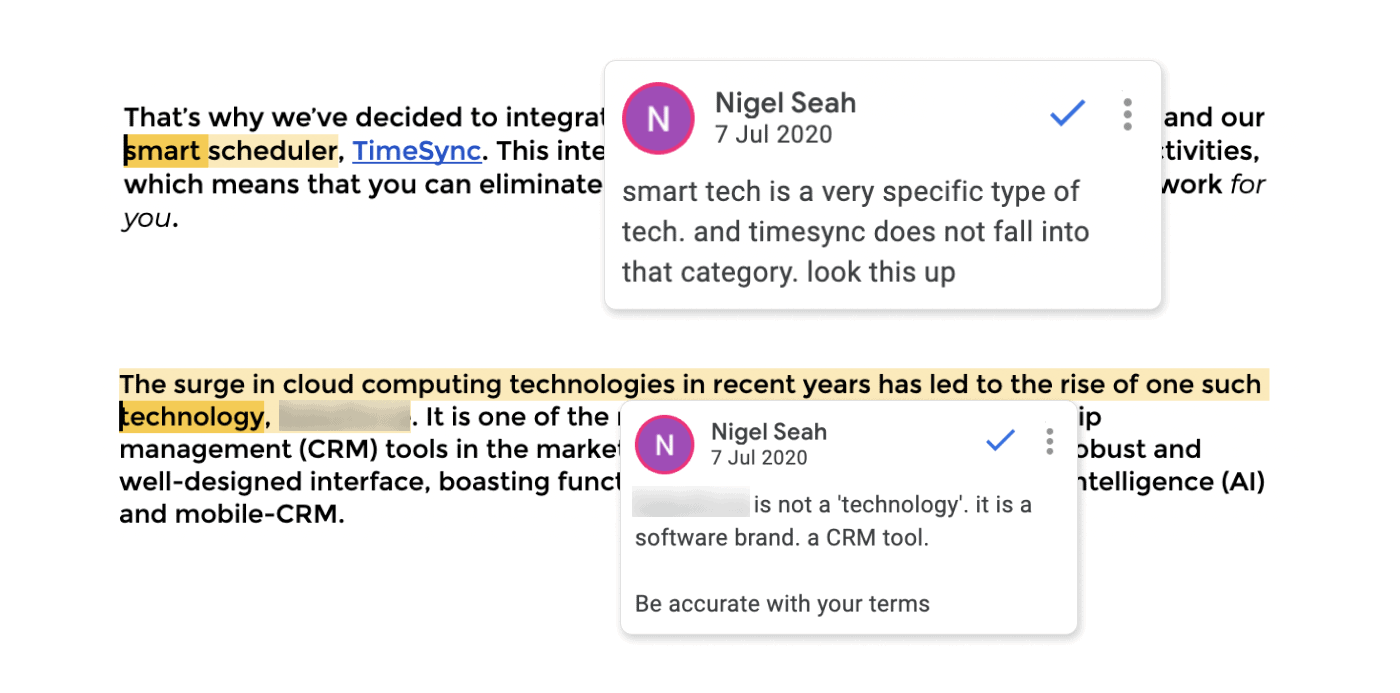

Start driving better conversations.
Novocall will be your new favorite business phone system.
Current mood: Accomplished. Even though I still have lots to work on, I’ve definitely improved! 💪
I always thought that I wrote pretty well – no huge grammatical errors, a good flow… But oh, how I thought wrong.

Having had some content writing experience, I thought that it’d be a good idea to try for a SaaS content writer at a business phone system startup.
I was really excited to start churning out articles for the blog! And when I was handed my first article by my supervisor Nigel, I quickly got down to it.
It was only after he had edited my work and left comments when I realized that I had soooooooo much more to learn. Everything that could go wrong had gone wrong. It was like a big slap to the face.
But of course, what doesn’t kill you makes you stronger, right?
So I took the time to improve my writing and gained as much as I could from the comments given to me.

I even wrote all the important points on a post-it note and stuck it to my laptop so I would be reminded every time I saw it.
In case you can’t read my handwriting, don’t worry. I’m gonna go through all these points below.
Here are the top 12 writing tips I learned from writing at a SaaS startup.
Before we even start on things like doing research and drafting the skeleton of the article, ask yourself, “Why am I writing this piece?” 🤔
This is the writing tip of writing tips because you essentially set the foundation for every other step in your entire process. Writing to educate your readers and writing to convert site visitors into leads are two very different things.
Based on your goal, these will change:
This brings me to my next point.
Now that we’ve established our end goal, let’s identify who our readers are. This is important as it will shape the tone and content format of your article.
In general, I use the marketing funnel as a guide. The most widely used funnel framework divides the funnel into three parts. The top of the funnel (TOFU), middle of the funnel (MOFU), and the bottom of the funnel (BOFU).

Let’s take a look at how each funnel stage affects the type of audience we are writing for and the content format as well.
People who are:
| Informational/educational articles that answer the “what is” and “how to” questions. | |
People who are:
| Listicles that showcase the available solutions in the market. | |
People who are:
| Comparison articles and case studies. |
P.S. I created this table purely from a SaaS perspective. This may or may not be relevant to other industries. But feel free to check out how we format the articles above 👆👆👆
Maybe because this has already been a habit of mine ever since I started learning how to write, it’s almost impossible not to do it.
I’ve noticed how having a simple draft can help to direct your thoughts and writing down a clearer path.
Let’s take a look at an example. I wrote a piece about our products’ integration with Salesforce.

As you can see, once you have your main headers and points listed out, you’ll know exactly what to write for each part.
So remember to create a brief outline of your subtopics and other ideas that help to convey the main point across.
A big part of content writing is to do proper research before even starting to write.
Doing your research and reading from multiple sources gives you a better understanding of the topic at hand. You also get a better perspective and more ideas about how you want to write your content.
For example, if I’m writing a call tracking competitor comparison, these are some of the search queries I would Google:
I would then pick at least 5 different articles to get some inspiration for my own article.
Check out how other articles were written, what points they included, and where they got the information from.
There are many words in the English language that kinda mean the same thing, yet they don’t.
As embarrassed as I am to say this, there were many times when I used terms interchangeably and assumed that they meant the same thing.
Basically, I wasn’t specific with the terms.

Even for something as simple as a ‘lead’ vs ‘prospect’ vs ‘customer’, I didn’t clearly distinguish the terms.
Here’s another good example of this mistake:

I assumed that call tracking was the process of tracking the progress of your calls. In fact, it means to track calls down to its marketing source. The words have totally different meanings.
This could have changed the main point of the entire article…
So now, I always ask myself these questions:
And as Nigel always says, “Even if you’re 0.0001% unsure, Google it”.
Or, you know, check with someone. Just ask.
Make sure that you know exactly what you’re putting into your article before hitting the ‘publish’ button.
In all honesty, word choice was a tricky one for me to grapple with, especially when I first started out.
I kept trying to convey the message across by using terms that made sense grammatically, but didn’t actually make sense contextually.
For example, I used the term “email automator” to describe an email automating feature of a software. Grammatically, it’s not wrong.

BUT, if I had gone ahead to double-check if this word was indeed the correct term used, I would have found out that it’s actually an Apple Mac-exclusive feature.
Here are some other examples of me not looking up the terms and using them wrongly 😔

Once again, make sure you use your words correctly. Always Google or check with someone else if you’re unsure.
I think it’s common for many writers to use fluff to “beautify” their writing and lengthen sentences or essays. I’m definitely guilty of this. Quick writing tip. Don’t.
Fluffy writing is basically adding words that have no substance and don’t add value to the reader.

Some examples of fluffy content include:
Here’s what fluffy writing looks like:
Previously, for many businesses, this is the typical customer journey when leads arrive at your website: they develop interests and dial your hotline, but are then held in a line for a long time because your teams are busy, they get impatient, and gradually lose their original interests. With high call volume, your businesses risk losing these prospects with missed and dropped calls. Even after a successful connection, lead information is not captured, leading to inefficient sales conversations.
💡 Why this is fluffy:
Instead of going straight to the point and telling the reader that the typical customer journey is time-consuming, I went ahead and described the whole process. I even gave a possible scenario that probably makes the reader more confused as they read on. Totally unnecessary (just like that whole paragraph 🤭).
Improved, purposeful content:
The typical customer journey that many leads go through is unnecessarily time-consuming. Leads tend to lose patience if they wait too long before receiving a response and often end up approaching other competitor brands.
If you notice stereotypically fluffy words, check if you’ve explained it clearly and whether it’s necessary. If not, remove it because you’re just wasting words and not adding value to your readers’ understanding.
Now, this was a mistake I had difficulty correcting – I was repeating it months into writing for Novocall.
Again, I assumed that the reader would have the same knowledge about certain terms used. I thought they’d know what it meant. But when you’re in the world of SaaS, jargons are everywhere.
If you think executing your SEO strategy properly means that you’ll attract your intended audience, you’re not wrong. BUT, you can never be 100% sure that all those who click on search-optimized content are the people you want to attract.
Think words like Session Initiation Protocol (SIP), lead distribution, or lead scoring. They sound familiar and obvious to some of us in the field. But for our readers? Perhaps, perhaps not.
It really depends on the knowledge level of the person who ends up clicking the link to that piece of content.
Let’s quickly look at some examples.

I didn’t make it a point to explain what some terms meant. I wrote long and complex sentences that the average reader wouldn’t get straightaway.
This can potentially affect the bounce rate of your article. Your reader isn’t going to sit around and try to decipher what your content means, especially if it was written in a way that makes it difficult to understand. Avoid complex sentences and always explain tech jargon, and you should be fine.
That said, it’s always better to check your work to see if it’s simple to understand. You could also get someone else to check it for you. Two pairs of eyes are better than one. 👀👀
Yes, another obvious mistake made.
I always included points I thought were relevant and in the end, I lost focus and steered off-track.
For example, I wrote an article about cold calls, warm calls, and hot calls. Trust me when I say that this was the toughest article for me. I made so many mistakes. And most of them were issues of inconsistency in my writing.


So I planned to write about cold calling techniques. But instead, I wrote about cold-calling good practices. Two very different concepts there.

Again, my content didn’t match my main point and I even failed to include explanations of certain terms I used (I’m making two mistakes in one paragraph 😤).
Not properly linking back to the main topic of what you’re writing can cause confusion. You’re also wrongly educating readers if they had sought your article out to learn something.
Remember to stay focused and remind yourself about the topic you’re writing on. The content in the paragraphs should be aligned with the respective headers of each section. The content of all the sections should be aligned with the overall topic of the article.
Reread the paragraph after you’re done and ask yourself, “does this link back?”
Everyone makes mistakes. We’re only human.
We could have had a long day, or simply missed a mistake even though we’ve checked through.
That’s when having editing tools like Grammarly really comes in handy. It has helped pick out minute details that I missed or overlooked and fine-tuned my writing quite a bit.

Here’s a quick writing tip. Don’t rely on Grammarly. I only use it to support my writing and as an additional pair of eyes.
You should still have proper writing skills if you want to be putting good quality content out there for your audience.
Proofreading is what every content writer should be doing after they’re done with their work. It’s almost common sense.
But, here’s a crucial writing tip: proofread your work after giving yourself a break.
Now, I’m not saying take a break as in take a nap or go on a holiday. I mean just put the article aside for an hour or so and complete your other tasks for the day.
This helps to refresh your mind. You kind of let your mind rest and forget about the content of the article.
Then once you read through the article, you actually start to notice some things like:
This also helps you to check through all the points I mentioned earlier: whether you’ve used specific terms, if you’ve idiot-proofed your writing, whether your choice of words made sense, and so on.
I can’t emphasize how important this step is, and how it has saved me (and Nigel) a lot of time editing the articles.

Just look! If only I had put the article aside for a while and went back to check it again, I could have avoided writing something like this. 😩
So always, always, take a short break then proofread your work.
Did you know that I was really, very, totally excited to write about this?
See what I did there? Those are filler words. They’re words that don’t add any value to the sentence.
While it’s not wrong to use these words in your sentences, don’t overuse them. It prevents you from getting the message across concisely.
Sad to say, I was guilty of this, just like how I often used fluffy language.
So make sure you check your work and spot these filler words. Remove them if you realize they’re appearing too often in your paragraphs.
I hope my learning experiences will help you avoid the writing mistakes I made!
To quickly sum up the writing tips I’ve learned over the months:
And one issue that kept recurring in my writing journey was that I always assumed things. Take it from me and NEVER do that!
Nonetheless, there are still many things I have yet to learn and grasp. After all, we’re always learning. But I’ll be sure to share more writing tips and ‘what-not-to-do’s in the future!
Whether you are writer for a company blog, a marketing magazine, a lifestyle blog, or a freelance content writer, these tips will serve you well.
Till next time 😊

Faye is a digital marketing executive at Novocall. When she’s not busy writing articles for Novocall’s blog, she spends her time baking and playing with her dogs.
Discover more
Subscribe to our blog
Get insights & actionable advice read by thousands of professionals every week.

